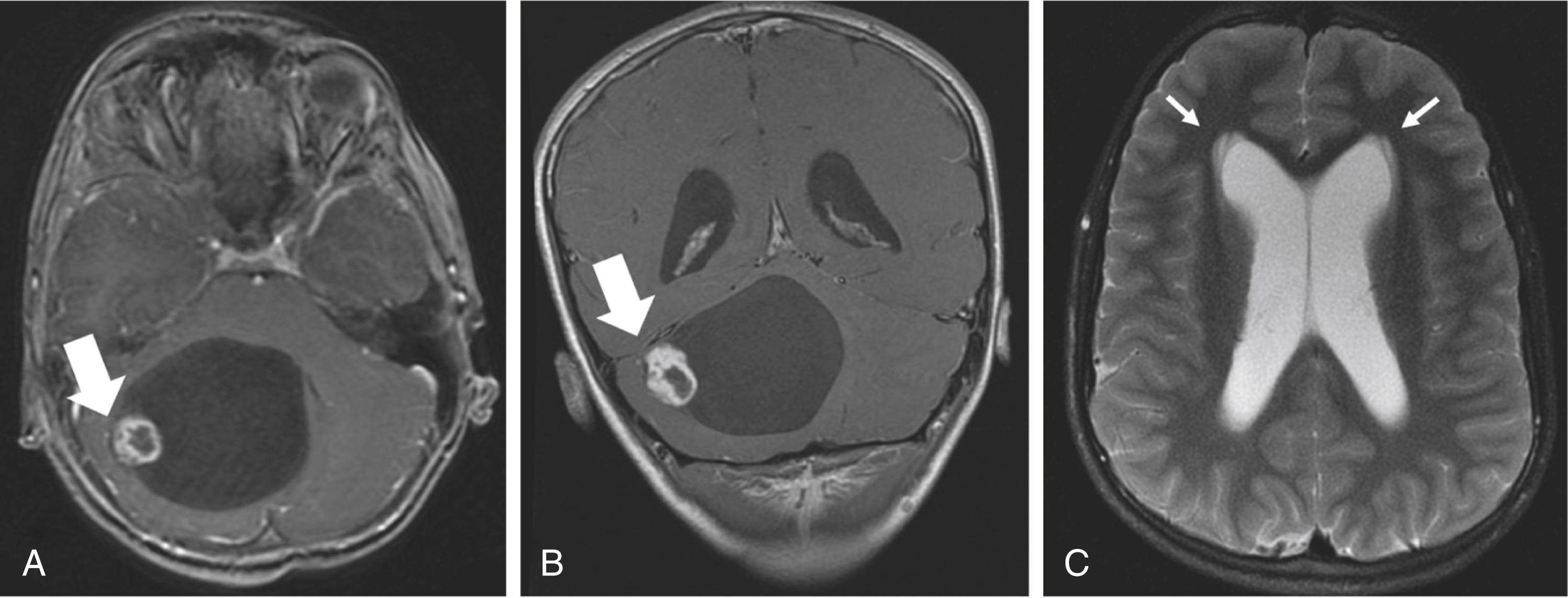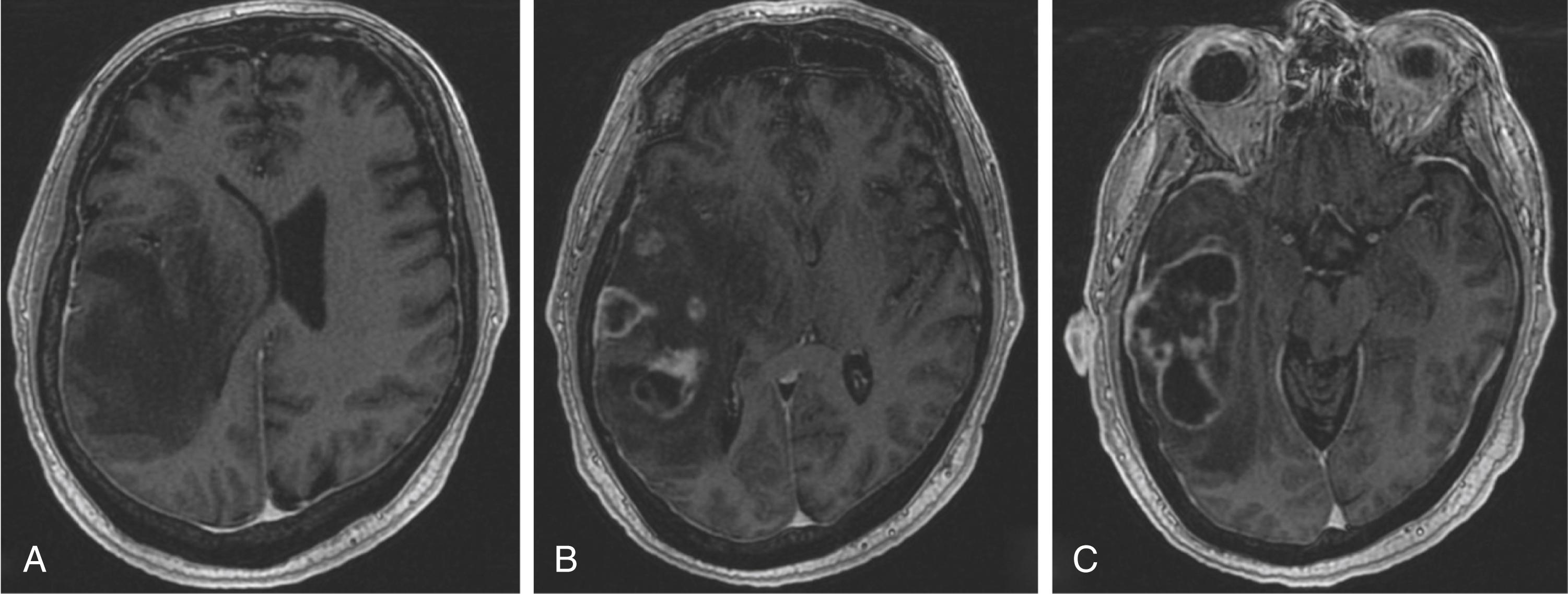Physical Address
304 North Cardinal St.
Dorchester Center, MA 02124
For tumors affecting the brain and spinal cord, surgical resection is the fastest and most definitive treatment. In some cases, it is also the safest, such as when mass effect from the tumor compresses vital structures or when cerebral edema causes a life-threatening rise in intracranial pressure (ICP). Before making the decision to operate, the surgeon must weigh the risks and benefits to the patient. Possible complications of surgery include infection, hemorrhage, cerebrospinal fluid flow disruption, and sequelae of damage to the nervous system, including weakness, loss of sensation, aphasia, coma, or death. Not all patients are good surgical candidates, because of high systemic disease burden, short expected survival time, or medical problems precluding anesthesia. For patients who undergo radiation, the ability to heal at an in-field surgical incision is another consideration. In this chapter, we will review key clinical principles in the surgical management of several different types of brain and spine tumors including: posterior fossa masses, unresectable and resectable high-grade gliomas, spinal cord tumors, and central nervous system metastases.
Case . An 11-year-old, previously healthy male presented with 5 weeks of headaches and dizziness. These headaches were worst in the morning and were also associated with nausea. Neurological examination showed mild dysmetria of the right upper extremity, truncal ataxia, and subtle bilateral cranial nerve VI palsies concerning for elevated ICP. MRI Brain demonstrated a 6 × 7 cm 2 cystic mass in the right cerebellum with an enhancing mural nodule ( Fig. 2.1 , large white arrows) and enlarged ventricles with transependymal flow consistent with hydrocephalus ( Fig. 2.1 , small white arrows). Due to the clinical and imaging signs of hydrocephalus, he was taken to the operating room emergently. A right suboccipital craniotomy was performed for gross total resection of the mass. Pathology was consistent with World Health Organization (WHO) grade 1 pilocytic astrocytoma. Postoperatively, he recovered well and was followed in clinic with serial MRIs and has had no recurrence of his tumor.

Teaching Points: Posterior Fossa Tumors. This case highlights two important principles including: (1) the management of increased ICP and (2) outcomes for pediatric patients with pilocytic astrocytoma. Patients with posterior fossa masses frequently present with obstructive hydrocephalus because of mass effect on the fourth ventricle. Clinical symptoms of elevated ICP include headache that awakens the patient in the early morning, unexplained nausea, and vision changes. Bilateral cranial nerve VI palsies or papilledema may be present on examination. The presence of hydrocephalus is an important surgical consideration, as it indicates that the mass should be resected in a more urgent or even emergent fashion. In most cases, the ICP increases slowly over time, which allows the patient to accommodate it. However, if the fourth ventricle becomes acutely obstructed, there may be sudden and dangerous increases in ICP. If a patient is acutely herniating, an external ventricular drain should be placed first as a temporizing measure before proceeding to the operating room for resection of the mass. In most cases, the hydrocephalus resolves postoperatively and patients do not require permanent ventricular shunt placement.
Another important surgical consideration is the extent of resection that is achieved for juvenile pilocytic astrocytomas. Gross total resection has been shown to improve progression-free survival and, in some cases, provide a surgical cure. When feasible, the surgeon should aim for total resection of the mass rather than just decompression of the posterior fossa. Pilocytic astrocytomas that are not completely resected have a higher rate of recurrence and are either observed or, in some cases, radiation therapy is considered.
Clinicians must be aware of symptoms of increased ICP including early morning headache, unexplained nausea, vision changes, bilateral cranial nerve VI palsies, and papilledema.
Obstructive hydrocephalus from a posterior fossa mass requires urgent or emergent surgical evaluation for resection or ventricular decompression.
Children with posterior fossa pilocytic astrocytomas generally have excellent outcomes, particularly when gross total resection is achieved.
Case . A 64-year-old male presented with 4 days of confusion and left hemibody weakness. On examination, his left hemibody motor strength was 4+/5 with left pronator drift. MRI Brain showed a 3 × 6 cm 2 lobulated, multifocal ring-enhancing mass in the right temporal lobe, with surrounding cerebral edema ( Fig. 2.2 ). Past medical history was significant for both bladder and prostate cancer—the bladder cancer was recently diagnosed and thought to be superficial; the prostate cancer had been previously treated with cryoablation.

One surgical option in this case is to obtain a tissue diagnosis via biopsy. However, based on the large size of the mass and the degree of surrounding cerebral edema, it was decided that the patient would benefit from surgical resection. The left-sided weakness noted in this patient was thought to be due to cerebral edema that extended up into the right motor cortex rather than direct tumor involvement. The patient was started on dexamethasone 10 mg intravenous once followed by 4 mg oral every 6 hours for management of edema and levetiracetam for seizure prevention given the location of the mass in the temporal lobe. A right temporal craniotomy was performed with gross total resection of the mass on the day after admission, and pathology was consistent with a WHO grade 4 glioblastoma (GBM).
Teaching Points: Surgical Management of Resectable Supratentorial Masses. This case highlights the role of surgery for (1) tissue diagnosis, (2) cytoreduction of a tumor, and (3) symptom relief from cerebral edema. Though it would be rare to have prostate cancer or superficial bladder cancer metastasis to the brain with this appearance, it is impossible to make a definitive diagnosis based on imaging characteristics alone. In general, any patient who presents with a new brain mass and no established primary cancer needs tissue for diagnosis. In rare cases, a single brain mass with imaging findings concerning for high-grade glioma will be found histologically to be the first presentation of a brain metastasis even if no other masses are visualized on systemic imaging. In addition, histologic determination of WHO grade and molecular profiling of tumor tissue help guide treatment and prognosis discussions and cannot be determined without tissue (see Chapter 1 for further discussion of molecular classification of brain tumors).
In general, surgical options for a supratentorial mass include biopsy or resection. Biopsy is often performed stereotactically, though in selected cases, open biopsy may be pursued. The extent of resection is determined to be either gross total (e.g., no residual tumor) or subtotal resection based on postoperative imaging typically performed between 24–72 hours after surgery. The decision to pursue resection is guided by multiple factors, including the size of the mass, superficial location, proximity to eloquent cortex or white matter tracts, and overall patient prognosis. Greater extent of surgical resection is associated with improved functional outcomes for patients with high-grade gliomas, although not necessarily with greater survival. Factors that favor tumor resection are size >3 cm, location in non-eloquent brain tissue, superficial or easily surgically accessible location, or a patient who is expected to survive long enough to recover and benefit from surgery.
Become a Clinical Tree membership for Full access and enjoy Unlimited articles
If you are a member. Log in here